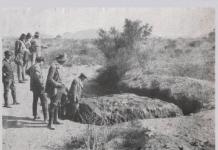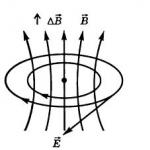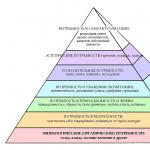Astrophysicists from Canada claim that the mass of the stream of meteorites bombarding our long-suffering planet exceeds 21 tons per year. But in most cases this goes unnoticed, since a person can observe and find meteorites only in the habitable zone.
The share of land on the Earth's surface is only 29%; the rest of the planet is occupied by the World Ocean. But even from this 29% it is necessary to take away places that are not inhabited by humans or are completely unsuitable for habitation. Therefore, finding a meteorite is a great success. However, there was a case when a meteorite itself found a person.
The case of a meteorite colliding with a person
In the entire history of celestial bodies falling to Earth, only one officially documented case of direct contact of a meteorite with a person is known.
It happened in the USA on November 30, 1954. A four-kilogram meteorite broke through the roof of a house and injured the owner’s leg. This means that there is still a risk that a more serious guest from outer space could fall on people’s heads. I wonder what the largest meteorite fell on our planet?
Meteorites are divided into three categories: stony, stony-iron and iron. And each of these categories has its own giants.
The largest stone meteorite
Relatively recently, on March 8, 1976, space presented the Chinese with a gift in the form of stones falling to the surface of the earth for 37 minutes. One of the fallen specimens weighed 1.77 tons. It was the largest meteorite that fell to earth, having the structure of a rock. The incident occurred near the Chinese province of Jilin. The space guest received the same name.
To this day, the Jilin meteorite remains the largest rock meteorite discovered on earth.
Largest ironstone meteorite
The largest representative of the category of iron-stone meteorites weighed 1.5 tons. It was found in 1805 in Germany.
A fellow German meteorite, found in Australia, weighed only 100 kg less than the German one.
But everyone was surpassed by the iron guest from space, whose weight was tens of times greater than all previously found meteorites.
Largest iron meteorite

In 1920, an iron meteorite with a diameter of 2.7 meters and weighing over 66 tons was discovered in southwestern Namibia! A larger specimen than this has never been found on our planet. It turned out to be the largest meteorite to fall to Earth. It was named after the Goba West farm, whose owner came across it while cultivating a field. The approximate age of the iron block is 80 thousand years.
Today it is the largest solid block of natural iron.

In 1955, the largest meteorite that fell to earth, Goba, was declared a national monument and taken under state protection. This was a necessary measure, since over the 35 years that the meteorite was in the public domain, it lost 6 tons in mass. Part of the weight was lost as a result of natural processes - erosion. But numerous tourists made the main contribution to the “weight loss” process. Now you can approach the celestial body only under supervision and for a fee.

The meteorites mentioned above are, of course, the largest in their category ever discovered. But the question of which largest meteorite fell to earth remained open.
The meteorite that killed the dinosaurs
Everyone knows the sad story of the extinction of dinosaurs. Scientists are still arguing about the cause of their death, but the version that a meteorite was the culprit of the tragedy remains the main one.
According to scientists, 65 million years ago the Earth was hit by a huge meteorite, which caused a catastrophe on a planetary scale. The meteorite fell on the territory that now belongs to Mexico - the Yucotan Peninsula, near the village of Chicxulub. Evidence of this fall was the impact crater found in 1970. But since the depression was filled with sedimentary rocks, they did not carefully examine the meteorite. And only 20 years later scientists returned to study it.

As a result of the work, it turned out that the crater left by the meteorite has a diameter of 180 km. The diameter of the meteorite itself was about 10 km. The impact energy during the fall was 100,000 Gtv (this is comparable to the simultaneous explosion of 2,000,000 of the largest thermonuclear charges).
It is assumed that a tsunami was formed as a result of the meteorite impact, the wave height varied from 50 to 100 meters. The dust particles raised during the impact tightly blocked the Earth from the Sun for several years, which led to a sharp climate change. and periodic large-scale fires aggravated the situation. An analogue of nuclear winter has arrived on the planet. As a result of the disaster, 75% of animal and plant species became extinct.
Nevertheless, officially the Chicxulub meteorite is the largest meteorite that fell to earth 65 million years ago. He practically destroyed all life on the planet. But in history it ranks only third in size.
First among the giants
Presumably 2 billion years ago, a meteorite fell on Earth, leaving a mark 300 km in diameter on its surface. The meteorite itself supposedly had a diameter of more than 15 km.
The crater left after the fall is located in South Africa, in the Free State province, and is called Vredefort. This is the largest impact crater, and was left by the largest meteorite that fell to Earth in the entire history of our planet. In 2005, the Vredefort Crater was listed as a UNESCO World Heritage Site. The largest meteorite that fell to Earth did not leave a photo as a souvenir, but a huge scar in the form of a crater on the surface of our planet will not allow us to forget about it.

It has been noticed that the fall of meteorites, the size of which is measured at least tens of meters, occurs with a periodicity of hundreds of years. And larger meteorites fall even less frequently.
According to scientists, a new guest wants to visit Earth in 2029.
Meteorite named Apophis
The meteorite that threatens our planet was named Apophis (that was the name of the snake god, who was the antipode of the sun god Ra in Ancient Egypt). It is not known for certain whether it will fall to Earth or miss and pass near the planet. But what happens if a collision does occur?
Scenario of Apophis colliding with Earth
So, it is known that the diameter of Apophis is only 320 meters. When it falls to Earth, there will be an explosion equal in power to the 15,000 bombs dropped on Hiroshima.

If Apophis hits the mainland, an impact crater will appear, having a depth of 400-500 meters and a diameter of up to 5 km. The resulting explosion will destroy permanent structures at a distance of 50 km from the epicenter. Buildings that do not have the strength of a brick house will be destroyed at a distance of 100-150 km. The column of dust will rise to a height of several kilometers and then cover the entire planet.
Stories spread by the media about nuclear winter and the end of the world are too exaggerated. The size of the meteorite is too small for such consequences. The temperature may drop by 1-2 degrees, but after six months it will return to normal. That is, the predicted catastrophe, if it does happen, will be far from global.
If Apophis falls into the ocean, which is more likely, a tsunami will occur that will cover coastal areas. The height of the wave will depend on the distance between the shore and the location of the meteorite fall. The initial wave can be up to 500 meters high, but if Apophis falls in the center of the ocean, then the wave reaching the shore will not exceed 10-20 meters. Although this is also quite serious. The storm will continue for several hours. All these events should be considered only as possible with some degree of probability. So will Apophis collide with our planet or not?
The probability of Apophis falling to Earth
Apophis will theoretically threaten our planet twice. The first time - in 2029, and then - in 2036. After conducting observations using radar installations, a group of scientists completely ruled out the possibility of a meteorite colliding with the earth. As for 2036, today the chance of a meteorite colliding with the Earth is 1:250,000. And every year, as the accuracy of calculations increases, the probability of a collision decreases.
But even with this probability, various options for forcing Apophis to deviate from course are being considered. Apophis is thus an object of interest rather than threat.
In conclusion, I would like to note that meteorites are severely destroyed when entering the earth’s atmosphere. When approaching the Earth, the falling speed of guests from space is 10-70 km/sec, and upon contact with a gaseous atmosphere, which has a fairly high density, the temperature of the meteorite increases to critical, and it simply burns up or is very badly destroyed. Thus, the atmosphere of our planet is the best protector against uninvited guests.
Meteorites have fallen to earth countless times. There were also those that could completely erase the very fact of the existence of dinosaurs. But the events took place so long ago that it is not possible to find the remains of these cobblestones.
Meteorite Tsarev
In December 1922, residents of the Astrakhan province were able to observe a stone falling from the sky: eyewitnesses said that the fireball was enormous in size and made a deafening noise in flight.Afterwards there was an explosion, and then it started raining stones. The next day, farmers living in that area found fragments of stones of a strange shape and appearance in their fields. 
A total of 82 chondritic meteorites were found, with debris scattered over an area of 25 km2. The largest fragment weighs 284 kg, and the smallest is only 50 grams. 
Goba meteorite
The largest intact meteorite in the world is the Goba meteorite: it is located in Namibia and is a block weighing about 60 tons. The surface of the meteorite is iron without any impurities.
Only dinosaurs could have observed Goba's fall to Earth: it fell on our planet in prehistoric times and was buried underground for a long time, until in 1920 it was discovered by a local farmer while plowing a field.

Now the site has been given the status of a national monument, and anyone can see it for a small fee. It is believed that when it fell it weighed 90 tons.

Allende meteorite
The meteorite fell to Earth on February 8, 1969 in the Mexican state of Chihuahua - it is considered the largest carbonaceous meteorite on the planet, and at the time of its fall its mass was about five tons.
Today, Allende is the most studied meteorite in the world: its fragments are stored in many museums around the world, and it is notable primarily for the fact that it is the oldest discovered body in the Solar System, the age of which has been accurately determined - it is about 4.5 billion years old.

Sikhote-Alin meteorite
On February 12, 1947, a huge block fell in the Ussuri taiga - the event could be observed by residents of the village of Beitsukhe in the Primorsky Territory: as always happens in the case of a meteorite fall, witnesses spoke of a huge fireball, the appearance and explosion of which was followed by a rain of iron fragments, fell over an area of 35 km².
The meteorite did not cause significant damage, but it made a number of craters in the ground, one of which was six meters deep. It is assumed that the mass of the meteorite at the time it entered the Earth's atmosphere ranged from 60 to 100 tons: the largest fragment found weighs 23 tons and is considered one of the ten largest meteorites in the world.


Tunguska meteorite
On June 17, 1908, at seven o'clock local time, an air explosion with a power of about 50 megatons occurred in the area of the Podkamennaya Tunguska River - this power corresponds to the explosion of a hydrogen bomb.
The explosion and the subsequent blast wave were recorded by observatories all over the world, huge trees on an area of 2000 km² from the supposed epicenter were uprooted, and not a single intact glass was left in the houses of residents. After this, for several more days the sky and clouds in this area glowed, including at night.


We highly recommend meeting him. There you will find many new friends. In addition, this is the fastest and most effective way to contact project administrators. The Antivirus Updates section continues to work - always up-to-date free updates for Dr Web and NOD. Didn't have time to read something? The full contents of the ticker can be found at this link.
Consequences of meteorites of various diameters falling to the ground
The previous post assessed the danger of an asteroid threat from space. And here we will consider what will happen if (when) a meteorite of one or another size does fall to Earth.
Meteor shower over Paris
The scenario and consequences of such an event as the fall of a cosmic body to Earth, of course, depends on many factors. Let's list the main ones:
Size of cosmic body
This factor, naturally, is of primary importance. Armageddon on our planet can be caused by a meteorite 20 kilometers in size, so in this post we will consider scenarios for the fall of cosmic bodies on the planet ranging in size from a speck of dust to 15-20 km. More - there is no point, since in this case the scenario will be simple and obvious.
Compound
Small bodies of the Solar System can have different compositions and densities. Therefore, there is a difference whether a stone or iron meteorite falls to Earth, or a loose comet core consisting of ice and snow. Accordingly, to cause the same destruction, the comet's nucleus must be two to three times larger than an asteroid fragment (at the same falling speed).
For reference: more than 90 percent of all meteorites are stone.
Speed
Also a very important factor when bodies collide. After all, here the transition of kinetic energy of motion into heat occurs. And the speed at which cosmic bodies enter the atmosphere can vary significantly (from approximately 12 km/s to 73 km/s, for comets - even more).
The slowest meteorites are those that catch up with the Earth or are overtaken by it. Accordingly, those flying towards us will add their speed to the orbital speed of the Earth, pass through the atmosphere much faster, and the explosion from their impact on the surface will be many times more powerful.
Where will it fall
At sea or on land. It’s hard to say in which case the destruction will be greater, it’s just that everything will be different.
A meteorite may fall on a nuclear weapons storage site or a nuclear power plant, then the environmental damage may be greater from radioactive contamination than from the meteorite impact (if it was relatively small).
Angle of incidence
Doesn't play a big role. At those enormous speeds at which a cosmic body crashes into a planet, it does not matter at what angle it will fall, since in any case the kinetic energy of movement will turn into thermal energy and be released in the form of an explosion. This energy does not depend on the angle of incidence, but only on mass and speed. Therefore, by the way, all craters (on the Moon, for example) have a circular shape, and there are no craters in the form of trenches drilled at an acute angle.
How do bodies of different diameters behave when falling to Earth?
Up to several centimeters
They completely burn up in the atmosphere, leaving a bright trail several tens of kilometers long (a well-known phenomenon called meteor). The largest of them reach altitudes of 40-60 km, but most of these “specks of dust” burn up at altitudes of more than 80 km.

Lyrid meteor shower photo 2009
Mass phenomenon - within just 1 hour, millions (!!) of meteors flash in the atmosphere. But, taking into account the brightness of the flashes and the observer’s viewing radius, at night in one hour you can see from several to dozens of meteors (during meteor showers - more than a hundred). Over the course of a day, the mass of dust from meteors deposited on the surface of our planet is calculated in hundreds and even thousands of tons.
From centimeters to several meters
Fireballs- the brightest meteors, the brightness of the flash exceeds the brightness of the planet Venus. The flash may be accompanied by noise effects, including the sound of an explosion. After this, a trail of smoke remains in the sky.
Fragments of cosmic bodies of this size reach the surface of our planet. It happens like this:
- a meteoroid crashes into the Earth's atmosphere (altitude about 120 km);
- almost immediately it heats up to the glow temperature, its speed gradually decreases;
- falling, the body collects more and more air molecules in front of itself, that is, it creates a zone of increased pressure;
- if at some point the flying cobblestone cannot withstand the pressure it creates, then an explosion occurs;
- at an altitude of several kilometers, the cosmic velocity of the body or its fragments is completely extinguished and what remains simply begins to fall, obeying the force of gravity.

Bolide in the atmosphere
At the same time, stone meteoroids, and especially ice ones, are usually crushed into fragments due to explosion and heating. Metal ones can withstand pressure and fall onto the surface entirely:

Iron meteorite "Goba" measuring about 3 meters, which fell "entirely" 80 thousand years ago on the territory of modern Namibia (Africa)
If the speed of entry into the atmosphere was very high (oncoming trajectory), then such meteoroids have much less chance of reaching the surface, since the force of their friction with the atmosphere will be much greater. The number of fragments into which a meteoroid is crushed can reach hundreds of thousands; the process of their falling is called meteor shower.
Over the course of a day, several dozen small (about 100 grams) fragments of meteorites can fall to Earth in the form of cosmic fallout. Considering that most of them fall into the ocean, and in general, they are difficult to distinguish from ordinary stones, they are found quite rarely.
The number of times cosmic bodies about a meter in size enter our atmosphere is several times a year. If you are lucky and the fall of such a body is noticed, there is a chance to find decent fragments weighing hundreds of grams, or even kilograms.
17 meters - Chelyabinsk bolide
Superbolide is the name sometimes given to particularly powerful meteoroid explosions, such as the one that exploded in February 2013 over Chelyabinsk. The initial size of the body that then entered the atmosphere varies according to various expert estimates, on average it is estimated at 17 meters. Weight - about 10,000 tons.

Chebarkul meteorite
The object entered the Earth's atmosphere at a very acute angle (15-20°) at a speed of about 20 km/sec. It exploded half a minute later at an altitude of about 20 km. The power of the explosion was several hundred kilotons of TNT. This is 20 times more powerful than the Hiroshima bomb, but here the consequences were not so fatal because the explosion occurred at a high altitude and the energy was dispersed over a large area, largely away from populated areas.
Less than a tenth of the meteoroid's original mass reached Earth, that is, about a ton or less. The fragments were scattered over an area more than 100 km long and about 20 km wide. Many small fragments were found, several weighing kilograms, the largest piece weighing 650 kg was recovered from the bottom of Lake Chebarkul:

The largest fragment of the Chebarkul (Chelyabinsk) meteorite found, weight 650 kg
Damage: Almost 5,000 buildings were damaged (mostly broken glass and frames), and about 1.5 thousand people were injured by glass fragments.

Broken windows of houses - consequences of a meteorite fall near Chelyabinsk
A body of this size could easily reach the surface without breaking into fragments. This did not happen due to the too sharp angle of entry, because before exploding, the meteoroid flew several hundred kilometers in the atmosphere. If the Chelyabinsk meteoroid had fallen vertically, then instead of an air shock wave breaking the glass, there would have been a powerful impact on the surface, resulting in a seismic shock, with the formation of a crater with a diameter of 200-300 meters. In this case, judge for yourself about the damage and number of victims; everything would depend on the location of the fall.
Regarding repetition rates similar events, then after the Tunguska meteorite of 1908, this is the largest celestial body to fall to Earth. That is, in one century we can expect one or several such guests from outer space.
Tens of meters - small asteroids
The children's toys are over, let's move on to more serious things.
If you read the previous post, then you know that small bodies of the solar system up to 30 meters in size are called meteoroids, more than 30 meters - asteroids.
If an asteroid, even the smallest one, meets the Earth, then it will definitely not fall apart in the atmosphere and its speed will not slow down to the speed of free fall, as happens with meteoroids. All the enormous energy of its movement will be released in the form of an explosion - that is, it will turn into thermal energy, which will melt the asteroid itself, and mechanical energy, which will create a crater, scatter earthly rock and fragments of the asteroid itself, and also create a seismic wave.
To quantify the scale of such a phenomenon, we can consider, for example, the asteroid crater in Arizona:

This crater was formed 50 thousand years ago by the impact of an iron asteroid with a diameter of 50-60 meters. The force of the explosion was 8000 Hiroshima, the diameter of the crater was 1.2 km, the depth was 200 meters, the edges rose 40 meters above the surrounding surface.
Another comparable event in scale is the Tunguska meteorite. The power of the explosion was 3000 Hiroshima, but here there was a fall of a small comet nucleus with a diameter of tens to hundreds of meters, according to various estimates. Comet nuclei are often compared to dirty snow cakes, so in this case no crater appeared, the comet exploded in the air and evaporated, felling a forest over an area of 2 thousand square kilometers. If the same comet exploded over the center of modern Moscow, it would destroy all the houses right up to the ring road.
Drop Frequency asteroids tens of meters in size - once every few centuries, hundred-meter ones - once every several thousand years.
300 meters - asteroid Apophis (the most dangerous known at the moment)
Although, according to the latest NASA data, the probability of the Apophis asteroid hitting the Earth during its flight near our planet in 2029 and then in 2036 is practically zero, we will still consider the scenario of the consequences of its possible fall, since there are many asteroids that have not yet been discovered, and such an event can still happen, if not this time, then another time.
So... the asteroid Apophis, contrary to all forecasts, falls to Earth
The power of the explosion is 15,000 Hiroshima atomic bombs. When it hits the mainland, an impact crater with a diameter of 4-5 km and a depth of 400-500 meters appears, the shock wave demolishes all brick buildings in an area with a radius of 50 km, less durable buildings, as well as trees falling at a distance of 100-150 kilometers from the place falls. A column of dust, similar to a mushroom from a nuclear explosion several kilometers high, rises into the sky, then the dust begins to spread in different directions, and within a few days it spreads evenly across the entire planet.

Comparison of destruction zones of the Tunguska meteorite and the Apophis asteroid
But, despite the greatly exaggerated horror stories that the media usually scare people with, nuclear winter and the end of the world will not come - the caliber of “Apophis” is not enough for this. According to the experience of powerful volcanic eruptions that took place in the not very long history, during which huge emissions of dust and ash also occur into the atmosphere, with such an explosion power the effect of “nuclear winter” will be small - a drop in the average temperature on the planet by 1-2 degrees, after Six months or a year everything returns to its place.
That is, this is a catastrophe not on a global, but on a regional scale - if Apophis gets into a small country, he will destroy it completely.
If Apophis hits the ocean, coastal areas will be affected by the tsunami. The height of the tsunami will depend on the distance to the place of impact - the initial wave will have a height of about 500 meters, but if Apophis falls into the center of the ocean, then 10-20 meter waves will reach the shores, which is also quite a lot, and the storm will last with such mega-waves. there will be waves for several hours. If the impact in the ocean occurs not far from the coast, then surfers in coastal (and not only) cities will be able to ride such a wave: :) (sorry for the dark humor)

Tsunami caused by a small asteroid falling into the ocean
Recurrence frequency events of similar magnitude in the history of the Earth are measured in tens of thousands of years.
Let's move on to global disasters...
1 kilometer
The scenario is the same as during the fall of Apophis, only the scale of the consequences is many times more serious and already reaches a low-threshold global catastrophe (the consequences are felt by all of humanity, but there is no threat of the death of civilization):
The power of the explosion in Hiroshima: 50,000, the size of the resulting crater when it fell on land: 15-20 km. Radius of the destruction zone from blast and seismic waves: up to 1000 km.
When falling into the ocean, again, everything depends on the distance to the shore, since the resulting waves will be very high (1-2 km), but not long, and such waves die out quite quickly. But in any case, the area of flooded territories will be huge - millions of square kilometers.
The decrease in atmospheric transparency in this case from emissions of dust and ash (or water vapor falling into the ocean) will be noticeable for several years. If you enter a seismically dangerous zone, the consequences may be aggravated by earthquakes provoked by an explosion.
However, an asteroid of such diameter will not be able to tilt the Earth’s axis noticeably or affect the rotation period of our planet.
Despite not all the drama of this scenario, this is a fairly ordinary event for the Earth, since it has already happened thousands of times throughout its existence. Average repetition frequency- once every 200-300 thousand years.
An asteroid with a diameter of 10 kilometers is a global catastrophe on a planetary scale
- Hiroshima explosion power: 50 million
- The size of the resulting crater when it falls on land: 70-100 km, depth - 5-6 km.
- The depth of cracking of the earth's crust will be tens of kilometers, that is, right up to the mantle (the thickness of the earth's crust under the plains is on average 35 km). Magma will begin to emerge to the surface.
- The area of the destruction zone can be several percent of the Earth's area.
- During the explosion, a cloud of dust and molten rock will rise to a height of tens of kilometers, possibly up to hundreds. The volume of ejected materials is several thousand cubic kilometers - this is enough for a light “asteroid autumn”, but not enough for an “asteroid winter” and the beginning of an ice age.
- Secondary craters and tsunamis from fragments and large pieces of ejected rock.
- A small, but by geological standards, decent tilt of the earth's axis from the impact - up to 1/10 of a degree.
- When it hits the ocean, it results in a tsunami with kilometer-long (!!) waves that go far into the continents.
- In the event of intense eruptions of volcanic gases, acid rain is subsequently possible.
But this is not quite Armageddon yet! Our planet has already experienced even such enormous catastrophes dozens or even hundreds of times. On average this happens once once every 100 million years. If this happened at the present time, the number of victims would be unprecedented, in the worst case it could be measured in billions of people, and besides, it is unknown what kind of social upheaval this would lead to. However, despite the period of acid rain and several years of some cooling due to a decrease in atmospheric transparency, in 10 years the climate and biosphere would have been completely restored.
Armageddon
For such a significant event in the history of mankind, an asteroid 15-20 kilometers in size is required in the amount of 1 piece.
The next ice age will come, most of the living organisms will die, but life on the planet will remain, although it will no longer be the same as before. As always, the strongest will survive...
Such events have also happened many times in the history of the Earth. Since the emergence of life on it, Armageddons have occurred at least several, and perhaps dozens of times. It is believed that the last time this happened was 65 million years ago ( Chicxulub meteorite), when dinosaurs and almost all other species of living organisms died, only 5% of the chosen ones remained, including our ancestors.

Death of dinosaurs from an asteroid impact
Full Armageddon
If a cosmic body the size of the state of Texas crashes into our planet, as it happened in the famous film with Bruce Willis, then even bacteria will not survive (although, who knows?), Life will have to arise and evolve anew.

Death of the Earth
Conclusion
I wanted to write a review post about meteorites, but it turned out to be an Armageddon scenario. Therefore, I want to say that all the events described, starting from Apophis (inclusive), are considered theoretically possible, since they will definitely not happen in the next hundred years at least. Why this is so is described in detail in the previous post.
I would also like to add that all the figures given here regarding the correspondence between the size of the meteorite and the consequences of its fall to Earth are very approximate. Data in different sources differ, plus the initial factors during the fall of an asteroid of the same diameter can vary greatly. For example, it is written everywhere that the size of the Chicxulub meteorite is 10 km, but in one, as it seemed to me, authoritative source, I read that a 10-kilometer stone could not have caused such troubles, so for me the Chicxulub meteorite entered the 15-20 kilometer category .
So, if suddenly Apophis still falls in the 29th or 36th year, and the radius of the affected area will be very different from what is written here - write, I will correct it.
Surprises from space
At 9:20 a.m. on February 15, 2013, residents of the Urals and Kazakhstan witnessed an incredible space show: a bright fireball flashed over their heads and exploded over Chelyabinsk 13 seconds after entering the atmosphere. In the evening of the same day, the “big brother” of the Chelyabinsk meteorite, asteroid 2012 DA14 the size of a 15-story building, flew very close to the Earth. It flew at a distance of 26 thousand kilometers from our planet, so the second show did not happen.
The visit of the space guest did not result in casualties, but about one and a half thousand residents of the city and region suffered from broken windows and panic. Economic damage, according to regional officials, amounted to over a billion rubles.
Shot from DVR/youtube
The Chelyabinsk meteorite was the first whose fall was comprehensively studied and documented. The falling car was filmed on thousands of Chelyabinsk residents' car recorders, and a whole team of geologists led by Viktor Grokhovsky, who caught the Chelyabinsk from the bottom of Lake Chebarkul in October 2013, hunted for its remains.
The fall of Chelyabinsk, the largest object to collide with the Earth since the Tunguska meteorite, shook the public, politicians and the scientific community. Network users began to watch disaster films about asteroids and comets, and politicians were surprised to discover that the Earth is not in empty space, but surrounded by thousands of huge objects that threaten to destroy a large part of the planet.

The site of the fall of the Tunguska meteorite. Traces of a forest fire and forest fall
A direct result of the Chelyabinsk meteorite fall was a tripling of NASA's budget for monitoring and combating near-Earth objects. Russian officials have announced their readiness to create a system that would shoot down visitors from space using thermonuclear warheads, and promised to develop an early warning program under the auspices of the Ministry of Emergency Situations by 2020.
On both sides of the ocean, people had the same questions: why was the Chelyabinsk not discovered before it fell? How is it possible and is it possible in principle to combat such a cosmic threat? What do the falling celestial stones threaten us with and how much does it cost to protect ourselves from them?
Space Population Census
The answer to the question why the meteorite was not discovered in time is quite simple: small celestial bodies with a diameter of about 20 meters, like Chelyabinsk, are not considered by asteroid hazard experts to be capable of causing serious harm to the Earth and therefore do not closely monitor them.
Although scientists still keep an eye on such celestial stones with the help of robotic telescopes as part of the Catalina Sky Survey, Pan-STARRS and many other public and private initiatives. But the main “responsible” for the search for potential killers of humanity is the orbital infrared telescope WISE, which finds even asteroids invisible from Earth, which almost do not reflect light.

WISE telescope, photo: NASA
Based on the results of the work of the telescope, NASA in 2010 and 2011 published a catalog of near-Earth objects - about 18.5 thousand in total, and also used the danger criteria developed at the Massachusetts Institute of Technology (Turin scale), according to which all asteroids in the NEOWISE catalog were colored according to the probability of their collision with the Earth from white (no danger) to red (collision imminent).
Good news: as of today, all objects in this catalog are white. This means that so far scientists have not been able to find a single near-Earth asteroid whose probability of falling to Earth in the next 200 years exceeds 1%, or three on the Turin scale. Periodically, objects with non-zero danger scores appeared in the catalog, but as their orbits were refined, they quickly dropped first to one, and then to zero.
Two asteroids - Apophis and Bennu - were assigned very high hazard index values when they were discovered. Opened in 2004, the 350-meter Apophis (by the way, it was named not in honor of the ancient Egyptian god Apep, but in honor of the villain from the TV series Stargate: SG-1) first received a record two at that time, and then a four on the Turin scale. The collision with Earth was supposed to occur in 2036.

A photograph of the Itokawa asteroid taken during the Japanese Hayabusa mission in 2005. Presumably, the asteroid is identical in composition and size to Apophis. Photo: ISAS/JAXA
Two years later, when astronomers refined the asteroid’s orbit, it was lowered first to one and then to zero. The probability that Apophis will meet Earth is estimated at 0.00089%, or one chance in 112 thousand. Today, the most dangerous near-Earth object is considered to be the 500-meter Apollo asteroid 2009 FD, which may fall to Earth in 2185 with a probability of 0.29%.

Orbit of Apophis
As for objects the size of Chelyabinsk, scientists cannot estimate how often they can fall to Earth and whether the real threat is great. In 2011, at the first presentation of the NEOWISE catalog, NASA reported that today we know only about five thousand asteroids about one hundred meters in size, while their total number is estimated at several tens of thousands. The number of smaller objects within the main asteroid belt can reach a million.
Made from something
It is impossible to accurately assess the damage due to the fact that we know very little about the composition of asteroids, and this is critical information, without which it is impossible to assess the consequences of the fall of a hypothetical “Apophis” to Earth.
The idea of studying asteroids “in situ” has been in the minds of astronomers for quite some time. The pioneer in this matter was the Japanese Hayabusa probe, which went to the Itokawa asteroid in 2008 in order to collect soil samples. Due to numerous breakdowns and fantastic bad luck, the Hayabusa managed to collect only one and a half thousand dust particles, which it nevertheless delivered to Earth in 2010.

Hayabusa-2. Image: JAXA
In the winter of 2014, the successor to the unsuccessful probe, Hayabusa-2, set off for asteroid 1999 JU3, which will arrive at the target in 2018. In parallel, NASA is developing its own mission, OSIRIS-REx, which will fly to Bennu in 2016 with the same mission as Hayabusa.
The lack of specific data on the composition of asteroids does not prevent engineers from dreaming of defense systems against celestial guests. One of the many projects is the DE-STAR system, which should properly heat a dangerous asteroid and knock it off its path. According to the calculations of the authors of the idea, a platform 100 meters in size will be enough to push Apophis out of its orbit, and a ten-kilometer laser will be enough to completely evaporate it.
In addition, there are projects like the NEOShield or ISIS probes, a potential “companion” of OSIRIS-REx, which involve diverting asteroids from their intended course with a “right hook” - a collision with a heavy metal blank. As an option, engineers propose attaching a heavy satellite to the stone, which will change the orbit of the celestial body. Russian scientists from the Institute of Space Research are even planning to shoot down asteroids with the help of other asteroids.

Artist's rendering of OSIRIS-REx. Image: University of Arizona/Goddard/NASA
Until Hayabusa2 and OSIRIS-REx reach their targets, scientists can only guess at the exact mineral and chemical composition of the asteroids. The composition of celestial bodies can be determined from their spectra, but due to collisions with other bodies, the surface of asteroids can radically change color, so the spectrum will deceive astronomers. Without knowing the composition, one can only approximately estimate the consequences of the fall of space rocks, based on what disasters the Earth has already experienced in the past.
Well forgotten old
The most famous and studied trace of such falls is the Chicxulub crater on the Yucatan Peninsula in southern Mexico. The fall of a 10-kilometer cosmic “boulder” 65.5 million years ago left a crater with a diameter of 180 kilometers and led to catastrophic consequences: it is believed that it was because of the fall of the meteorite that dinosaurs and a fair part of the Mesozoic fauna became extinct.
And this is not the worst option: the diameter of the Vredefort crater in South Africa, apparently left by a meteorite, is 300 kilometers. The “pebble” fell to Earth about two billion years ago, when microbes dominated the planet. Just recently, scientists discovered in Australia an as yet unnamed crater with a diameter of 400 kilometers, which arose about 300-420 million years ago.
Another thing is that not many traces of encounters with small asteroids - up to several hundred meters - are known, so the consequences of the fall of such stones on cities and densely populated countries cannot be determined.
One of the few examples of such events is the so-called “Clovis Comet” - an object supposedly the size of the Tunguska meteorite (scientists do not agree whether it was an asteroid or a comet), which fell into the New World approximately 13 thousand years ago. Its fall caused large-scale fires, a sharp cooling due to clouds of ash and aerosol particles, the extinction of the remains of megafauna and the disappearance of the Clovis culture, the first tribes of the American Indians.
It was only in 2013 that geologists managed to localize the crash site of this object: it crashed in the province of Quebec in Canada, but the crater itself has not yet been found. So it may very well be that the Clovis Comet was relatively small.
What to do?
This question is regularly asked to the head of NASA and Russian space officials. As the current head of the American Space Agency put it, so far humanity has only one option - “pray,” since the problem has been ignored for decades and there are no effective means for destroying and 100% detecting asteroids.
Moreover, until the results of the Hayabusa and Osiris studies are received, as well as complete catalogs of near-Earth asteroids, governments are unlikely to allocate money for anything other than prayer. Politicians remember celestial surprises only when the next Chelyabinsk falls, and their ardor quickly cools when they see calculations of the amounts that need to be invested in protecting the Earth. So today humanity can only hope for commercial projects for the “development” of asteroids - perhaps the data they collect on small celestial bodies and comets will convince officials to seriously think about the future of the planet.
Alexander Telishev
According to some scientists, the one that exploded over Chelyabinsk was part of a larger asteroid, which contained a lot of iron. If there was even more of this iron, then most likely it would not have allowed the asteroid to break up in the upper atmosphere and it would have flown to the Earth, causing more significant destruction.
Iron would cause a fairly large crater to form. It's hard to say anything now, but its diameter would most likely be at least several tens of meters, says Campbell-Brown.
If the Chelyabinsk meteorite had turned out to be a comet, its speed alone would have caused serious destruction, says Mark Bailey, a comet expert and director of the Arman Observatory in Northern Ireland.
An asteroid enters the atmosphere at a speed of 42,000 to 90,000 km/h, and comets, in turn, can travel at a speed of 251,000 km/h. Energy is a function of the square of the speed, so if you double the speed of an object, you get four times the energy.
You wouldn't want that to happen,” Bailey comments.
Comets, due to their long-period orbit and enormous kinetic energy, have every chance of colliding at very high speeds, regardless of the frictional force that may be encountered upon entering the dense layers of the atmosphere.
From all this it follows that they can cause very serious destruction when colliding with the Earth. Perhaps, in some cases, much more serious than in collisions with larger asteroids.
Asteroid 2012 DA14. Diameter 30 meters
The spacecraft, which flew on February 15 at a distance of 27,500 km from Earth, was almost twice the size of the Chelyabinsk meteorite. If it collided with the Earth, it would have caused an explosion equivalent to a 2.4-megaton bomb. By comparison, the atomic bomb dropped on Hiroshima during World War II was equivalent to “only” 17 kilotons. This explosion killed approximately 70,000 people instantly. They literally evaporated.

In addition to the giant shock wave, an asteroid of this size could create a crater the size of a 1,200-meter crater near the city of Flagstaff in Arizona, which was formed by a meteorite impact. In this case, people, even those located at a distance of several kilometers from the center of the explosion, would feel that their clothes began to ignite.
Tunguska meteorite. Diameter from 60 to 100 meters

The Tunguska meteorite, or as some call it the Tunguska comet, still causes controversy among many scientists. The bottom line is that in June 1908, in the area of the Podkamennaya Tunguska River, an unknown cosmic body was the result of an explosion that released approximately 10 times more energy than in the case of the Chelyabinsk meteorite. The explosion destroyed 80 million trees located over an area of more than 2,000 square kilometers. Its blast wave, with a yield of 10 to 15 megatons, was about 1,000 higher than that of the Hiroshima bomb. Scientists are still arguing about what size this cosmic body was. And these disputes are further complicated by the fact that the exploding body did not form any crater. The only thing we can say with certainty is that the exploding body caused a huge but fleeting forest fire. On this occasion, the case was dubbed the Tunguska phenomenon and a theory was put forward that it was in fact not an asteroid, but a comet.
The object was so bright and its light so intense that it caused trees to heat up and catch fire. But the blast wave was so powerful that it also extinguished the fire, so the fire did not last long, says Brown.
As you know, most of the Earth's surface is covered with water. Therefore, if a cosmic body of this size fell into the ocean, it would most likely cause a supergiant tsunami. And if such a body fell, for example, on some city, then no one and nothing would survive.
It's not a pleasant feeling when your clothes catch fire. If the object fell on the city, it would cause a colossal number of casualties and massive destruction. Perhaps he would not have destroyed a large city, but he would have dealt with a city like New Orleans, where Hurricane Katrina took place.
In addition, comets of this size can serve to initiate processes of change at the global level. Although they will not last long. In the hemisphere where the explosion occurs, due to ice particles formed from a sharp temperature change, the sky will glow brightly for several days.
Asteroid Apophis. Diameter 350 meters

When asteroid Apophis 99942 was first discovered, early studies suggested it had a 2.7 percent chance of impacting Earth in . However, new research on this issue, fortunately, suggests that this will not happen. But if the situation had taken a less optimistic course, then the point of entry of this asteroid into the atmosphere would have passed over the northern part of South America. If this body fell, the number of victims could be up to 10 million, according to one study. An asteroid the size of Apophis would also cause a devastating tsunami that would be unstoppable by anything in its path.
When you have a piece in front of you that’s almost half a kilometer in size, it doesn’t really matter where exactly it hits the Earth,” Bailey says sadly.
It will cause such an explosion that it will cause global climate change because water will begin to evaporate into the atmosphere. The explosion will create a crater and raise gigantic masses of dust. Here we are already talking about a global catastrophe.
Asteroid 1950 DA. Diameter from 1.1 to 1.4 kilometers

Asteroid 1950 DA is one of the few large kilometer-long space objects in near-Earth space. Asteroids of this size have enough power to destroy entire nations. A kilometer-long asteroid is capable of creating a tsunami that will cover absolutely all coastal areas of the area. And so much dust will rise into the atmosphere that climate change will begin. Plants will simply stop growing due to lack of sunlight, there will be no harvests, and people will begin to feel hungry.
If we talk about asteroids about 10 kilometers in size, then we are already talking about extinction. For example, the diameter of the asteroid (or) that killed the dinosaurs ranged from 10 to 16 kilometers. In this case, not only your clothes, but the entire planet will catch fire. Long-term climate changes will occur and many species, including humans, will begin to die out.
Fortunately, scientists know about 94 percent of these giant asteroids. And we shouldn’t worry about them, at least for the next 100 years. It’s a different matter if we talk about much smaller space objects. Indeed, due to their small size, it is still difficult for scientists to calculate how many there are, where they are and whether they pose a danger to the Earth.

The same 2012 DA14 was discovered from an observatory located on Earth, but the Chelyabinsk meteorite could not have been detected even if they knew where to look in advance. Only because it was moving towards us from the direction of the Sun. True, new technologies, according to the same scientists, already make it possible to create high-tech infrared telescopes that can be installed in orbit around the Sun and which should help researchers solve such issues.


















